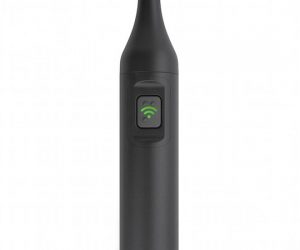
Hit The Go Button
AptoVision hires ex-Crestron gun as its AV-over-IP evangelist. First BlueRiver chip-based products hit market.
Kamran Ahmed
AptoVision CEO & Co-founder
AptoVision is Montreal-based technology licensing company, established to redefine the AV signal processing and distribution platform through its BlueRiver chip technology.
Justin Kennington
AptoVision Director of Strategic & Technical Marketing
Previously the technology manager of DigitalMedia at Crestron, Kennington is widely recognised as an influential technologist in pro AV. He received InfoComm’s Young AV Professional of The Year Award in 2014.
Gerry Raffaut
Managing Director
iMAGsystems is a Melbourne-based company and the first in Australia to leverage the capabilities of the AptoVision BlueRiver chipset with a range of ‘Lightning’ video-over-IP matrix products.
AV: Kamran, what’s AptoVision’s manifesto?
Kamran: AptoVision’s aim is to disrupt an US$8b worldwide market for AV signal distribution. We are disrupting it by bringing the technology over to IP. It’s not the first industry in the history of technology that this has happened to but there are major ramifications and some interesting challenges associated with it. Our job is to convince people. We’re not just pushing our technology to OEM manufacturers who are designing some exciting new product, we have to help our OEM partners to sell to the AV integration channel.
AptoVision is single-handedly bringing about this transition, there is no other chipset available in the world that’s doing it.
AV: So you’re pushing the tech and helping to create the demand.
Kamran: That’s right, we’re providing both the ‘push’ and the ‘pull’. We need to evangelise the market to not only move to this paradigm — and that’s already happening — but to be a catalyst for change.
AV: Tell me about the appointment of Justin Kennington.
Kamran: Justin is the best technology evangelist we could find. If you remember the days of HDMI in pro AV, VGA lasted a lot longer than it should have because everyone was afraid of what HDMI meant in terms of the challenges and the associated technology lagging behind. Then Crestron came in and took the lead with a product for HDMI that actually worked. Of course, there were still some growing pains but Crestron almost single-handedly moved the market to HDMI and Justin was a huge part of that transition — convincing the industry the products were there and ready.
Given that ability and that experience, he is, in our opinion, one of the best people to bring about this new transition, a transition that’s bigger than the HDMI transition.
Strategically that’s where we’re coming from.
AV: Where are you encountering resistance?
Justin: If you ask almost anyone attached to this industry if video will one day move over IP — everyone will respond in the affirmative. Everyone understands that it’s inevitable. Yet on a day-to-day basis it’s easy to say ‘AV over IP is the future’ and ‘we’ll get there one day’ but ‘I’ve got this job today I want to be conservative and do what I did yesterday’.
That’s what we encountered in 2008/9 in the transition from analogue to digital.
If you asked anyone: would you rather have a digital system? Then the answer, was ‘of course, digital’s great. That’s what I want’. But come time to design and install the system, the same guy may well revert to what he knows: ‘I don’t know how digital works. Let me go with my component video’.
I see my job as being a communicator. I want people to understand what’s possible and the benefits of the IP transition. But I also need to be an educator: not necessarily about the benefits, but also how to use it.
An installer/designer might understand the advantages but are daunted by the thought of dealing with an Ethernet switch. That’s where some education and training can help.
AV: How have the big names in the AV switching game responded to AptoVision?
Justin: The large players sell tens or hundreds of millions of dollars worth of traditional and relatively expensive matrix switches.
They need to understand that moving their profits to the end point devices and giving up their switch sales to, say, Cisco, is healthy and good for the industry in the longer term. Inevitably, if the large players don’t get on board with this then the small and medium players, seeing an opportunity to not have to design several models of complex matrix switches, will take advantage. They’ll build a few AV-over-IP end point devices, leverage the Cisco solution for the switch and they’ll be the big company in a few years and the entrenched players will be struggling. The hard pill to swallow is when innovation means cannibalising your own products. But that’s the lesser evil compared to having someone else cannibalise your products.
AV: The big theme of this year’s ISE was AV over IP — everyone’s doing it.
Justin: They’re all dabbling in AV over IP but they haven’t solved the problem of AV distribution, namely, zero latency and no compression in the distribution. The solutions that exist today from the big manufacturers use H.264, JPEG or JPEG2000. These solve a problem of being able to expand from a traditional AV infrastructure into, let’s say, some of your existing IT infrastructure, but it comes with the penalty of latency and of no synchronisation. By which I mean, the key to AptoVision technology and why this transition now makes sense is the ability to move sync’ed video data over necessarily asynchronous Ethernet networks.
“”
Ethernet has finally got the bandwidth to transport uncompressed video, that’s unique to our time in history. We’ve now got to a point where 10Gb Ethernet can carry uncompressed video up to 4K
Kamran: This may sound like a counterintuitive statement but we’re not going after the AV-over-IP market, we’re going after the proprietary switch market. We just happen to do it using AV over IP. We’re not going for the H.264 or JPEG2000 market because those applications already exist and they don’t require proprietary switches. So we’re not trying to come in and offer a better solution than compressed high-latency video over IP. For a certain market, compression and latency is acceptable. We’re providing an alternative to the $8b uncompressed signal distribution market and we’re doing it using IP.
Justin: The giants of the switching business, like Cisco have R&D budgets larger than most AV companies’ turnovers, so it doesn’t make sense for AV manufacturers to build custom-made switches when there’s this other industry out advancing the state of the art.
AptoVision’s products are based around transporting video over 10Gb Ethernet, meanwhile 25Gb Ethernet is coming close to a commodity reality and 100Gb products exist.
We want to enable the AV industry to take advantage of the leaps and bounds in technology happening on the other side of the fence so we can move faster.
Ethernet has finally got the bandwidth to transport uncompressed video, that’s unique to our time in history.
20 years ago when we had 10/100BaseT Ethernet, that wasn’t enough bandwidth to carry standard 480p VGA quality video. 10 years ago when we had gigabit Ethernet, that wasn’t enough to carry 720p or 1080i. We’ve now got to a point where 10Gb Ethernet can carry uncompressed video up to 4K.
The AptoVision roadmap and architecture is designed to handle higher speeds but also next-generation video technologies as our world moves to 8K. Turns out Ethernet has the bandwidth to handle that and AptoVision’s architecture can easily meet those needs.
AV: Where’s your growth going to come from?
Kamran: AptoVision allows companies to introduce high-performance AV signal distribution products without having to invest in hardware development. It’s allowing new players to get into these kinda systems at a product level. For example, in Australia, you’re seeing a new company called iMAGsystems coming out with some exciting video-over-IP product, while we announced another nine partners at ISE.
At a channel level, the IT channel will become more important. With AV residing on the network, the IT department will take over more of the responsibility of AV and therefore more of the purchasing decisions.
That’s where AptoVision is well placed. We have technology the IT guy can understand.
PLETHORA: FULL GAMUT
AptoVision has tinkered with its tech to introduce Plethora, the “first fully in-line engine for high fidelity processing of uncompressed audio and video signals”. Available on its BlueRiver NT+ and new BlueRiver 400 chipsets, the Plethora engine is named for the numerous functions it integrates into a single, in-line, zero-frame latency signal processing subsystem. These functions include broadcast-quality scaling, visually ‘indistinguishable’ light compression, colour space conversion, frame rate conversion, audio embedding/de-embedding, audio down-mixing and audio re-sampling.
Also available on new reference designs for its BlueRiver NT, BlueRiver NT+ and new BlueRiver 400 chipsets: point-to-point HD video signal extension of up to 250m (160m for 4K) over CAT-6a/CAT-5e network cabling.
AptoVision: www.aptovision.com
iMAG SYSTEMS: FIRST IN BEST DRESSED
Melbourne-based iMAGsystems has partnered with AptoVision to produce Lightning, an uncompressed, zero frame latency, video-over-IP matrix system using Cat6A. Lightning delivers HDMI video (up to 4K resolution) together with RS232/IR control and gigabit Ethernet over 10Gb networking infrastructure. It is ideal for routing computer video data through venues and corporate facilities using existing or standalone networks.
“The time is absolutely right for a product like Lightning,” offers Gerry Raffaut, iMAGsystems Managing Director. “We’re currently seeing interest from dozens of projects — commercial to hospitality, education and beyond — that are all seeing the compelling advantages of moving zero-latency, uncompressed full-definition video to the network. Lightning, with its unlimited scalability, is particularly attractive to larger commercial projects, but we’ve had strong interest from pubs and licensed clubs as well. Yes, we’re harnessing the power of the Blue
River chip but iMAGsystems has invested considerably into the control side. Having leveraged the many years of experience on how installers use video-over-IP products. Starting with a blank canvas we designed and engineered an API control box to make it easy for IT and non-IT types to configure and control any number of end points from third-party control systems.”
Proudly made in Melbourne, the Lightning API box firmly follows the company ethos of being easy to use and easy to install.
iMAGsystems: www.imagsystems.com
Further reading: For more on AV over IP, including Andy Ciddor’s excellent introduction to the BlueRiver chipset (‘HDBaseIP: The Way of the Future?’) and Derek Powell’s exposé on the AMX purchase of SVSI (‘This Changes Everything’) head to www.avapac.net and search on ‘AptoVision’.















RESPONSES